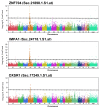Discovery of candidate genes for muscle traits based on GWAS supported by eQTL-analysis
- PMID: 24643240
- PMCID: PMC3957088
- DOI: 10.7150/ijbs.8134
Discovery of candidate genes for muscle traits based on GWAS supported by eQTL-analysis
Abstract
Biochemical and biophysical processes that take place in muscle under relaxed and stressed conditions depend on the abundance and activity of gene products of metabolic and structural pathways. In livestock at post-mortem, these muscle properties determine aspects of meat quality and are measurable. The conversion of muscle to meat mimics pathological processes associated with muscle ischemia, injury or damage in humans and it is an economic factor in pork production. Linkage, association, and expression analyses independently contributed to the identification of trait-associated molecular pathways and genes. We aim at providing multiple evidences for the role of specific genes in meat quality by integrating a genome-wide association study (GWAS) for meat quality traits and the detection of eQTL based on trait-correlated expressed genes and trait-associated markers. The GWAS revealed 51 and 200 SNPs significantly associated with meat quality in a crossbred Pietrain×(German Landrace×Large White) (Pi×(GL×LW)) and a purebred German Landrace (GL) population, respectively. Most significant SNPs in Pi×(GL×LW) were located on chromosomes (SSC) 4 and 6. The data of 47,836 eQTLs at a significance level of p<10(-5) were used to scale down the number candidate genes located in these regions. These SNPs on SSC4 showed association with expression levels of ZNF704, IMPA1, and OXSR1; SSC6 SNPs were associated with expression of SIGLEC10 and PIH1D1. Most significant SNPs in GL were located on SSC6 and associated with expression levels of PIH1D1, SIGLEC10, TBCB, LOC100518735, KIF1B, LOC100514845, and two unknown genes. The abundance of transcripts of these genes in muscle, in turn, is significantly correlated with meat quality traits. We identified several genes with evidence for their candidacy for meat quality arising from the integrative approach of a genome-wide association study and eQTL analysis.
Keywords: GWAS; SNP chip; eQTL; microarray; pork quality..
Conflict of interest statement
Competing interests: The authors declare that they have no competing interests.
Figures





Similar articles
-
Genome-wide analysis of expression QTL (eQTL) and allele-specific expression (ASE) in pig muscle identifies candidate genes for meat quality traits.Genet Sel Evol. 2020 Oct 9;52(1):59. doi: 10.1186/s12711-020-00579-x. Genet Sel Evol. 2020. PMID: 33036552 Free PMC article.
-
Genetic control of longissimus dorsi muscle gene expression variation and joint analysis with phenotypic quantitative trait loci in pigs.BMC Genomics. 2019 Jan 3;20(1):3. doi: 10.1186/s12864-018-5386-2. BMC Genomics. 2019. PMID: 30606113 Free PMC article.
-
Mapping QTL for white striping in relation to breast muscle yield and meat quality traits in broiler chickens.BMC Genomics. 2018 Mar 20;19(1):202. doi: 10.1186/s12864-018-4598-9. BMC Genomics. 2018. PMID: 29554873 Free PMC article.
-
Expression Quantitative Trait Loci Information Improves Predictive Modeling of Disease Relevance of Non-Coding Genetic Variation.PLoS One. 2015 Oct 16;10(10):e0140758. doi: 10.1371/journal.pone.0140758. eCollection 2015. PLoS One. 2015. PMID: 26474488 Free PMC article. Review.
-
Systematic review of gastric cancer-associated genetic variants, gene-based meta-analysis, and gene-level functional analysis to identify candidate genes for drug development.Front Genet. 2022 Aug 16;13:928783. doi: 10.3389/fgene.2022.928783. eCollection 2022. Front Genet. 2022. PMID: 36081994 Free PMC article.
Cited by
-
eSNPO: An eQTL-based SNP Ontology and SNP functional enrichment analysis platform.Sci Rep. 2016 Jul 29;6:30595. doi: 10.1038/srep30595. Sci Rep. 2016. PMID: 27470167 Free PMC article.
-
Integration of multi-omics approaches for functional characterization of muscle related selective sweep genes in Nanchukmacdon.Sci Rep. 2021 Mar 30;11(1):7219. doi: 10.1038/s41598-021-86683-4. Sci Rep. 2021. PMID: 33785872 Free PMC article.
-
Genetic diversity and breed-informative SNPs identification in domestic pig populations using coding SNPs.Front Genet. 2023 Nov 16;14:1229741. doi: 10.3389/fgene.2023.1229741. eCollection 2023. Front Genet. 2023. PMID: 38034497 Free PMC article.
-
Genetic diversity and divergence among Korean cattle breeds assessed using a BovineHD single-nucleotide polymorphism chip.Asian-Australas J Anim Sci. 2018 Nov;31(11):1691-1699. doi: 10.5713/ajas.17.0419. Epub 2018 Jul 26. Asian-Australas J Anim Sci. 2018. PMID: 30056676 Free PMC article.
-
Integrated Genome-wide association and hypothalamus eQTL studies indicate a link between the circadian rhythm-related gene PER1 and coping behavior.Sci Rep. 2015 Nov 5;5:16264. doi: 10.1038/srep16264. Sci Rep. 2015. PMID: 26537429 Free PMC article.
References
-
- Ponsuksili S, Murani E, Phatsara C. et al. Porcine muscle sensory attributes associate with major changes in gene networks involving CAPZB, ANKRD1, and CTBP2. Funct Integr Genomics. 2009;9:455–471. - PubMed
Publication types
MeSH terms
LinkOut - more resources
Full Text Sources
Other Literature Sources
Research Materials
Miscellaneous

